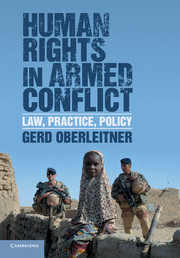Book contents
- Frontmatter
- Contents
- Acknowledgments
- Table of cases
- Table of Legal Instruments
- List of Abbreviations
- Introduction
- Part I Human rights in armed conflict: history of an idea
- Part II Human rights and humanitarian law: theory
- Part III Human rights and humanitarian law: challenges and commonalities
- Part IV The dynamics of war and law
- 13 The changing character of war
- 14 Governing internal armed violence
- 15 Human rights in situations of occupation
- 16 Context: the humanization of international law
- Part V Enforcement: practice and potential
- Conclusion
- Bibliography
- Index
- References
13 - The changing character of war
Published online by Cambridge University Press: 05 March 2015
- Frontmatter
- Contents
- Acknowledgments
- Table of cases
- Table of Legal Instruments
- List of Abbreviations
- Introduction
- Part I Human rights in armed conflict: history of an idea
- Part II Human rights and humanitarian law: theory
- Part III Human rights and humanitarian law: challenges and commonalities
- Part IV The dynamics of war and law
- 13 The changing character of war
- 14 Governing internal armed violence
- 15 Human rights in situations of occupation
- 16 Context: the humanization of international law
- Part V Enforcement: practice and potential
- Conclusion
- Bibliography
- Index
- References
Summary
War as risk management
While the application of international humanitarian law in internal armed conflicts, situations of occupation and peace support operations is usually well acknowledged (as will be discussed below), doubts are raised with regard to the (full) applicability of international human rights law in international armed conflicts. While internal armed conflicts are characterized by a (hostile) relationship between the government and those being governed akin to (peace-time) law enforcement scenarios and are thus obviously susceptible to the application of human rights law, in international armed conflicts the lex specialis principle is seen as overriding international human rights law on the grounds that humanitarian law is both exclusive and exhaustive. In such situations, it is argued, human rights cannot apply on the grounds of irreconcilable paradigmatic differences and legal obstacles, and they need not apply as they have nothing to contribute in terms of regulation above and beyond international humanitarian law. It is certainly correct that international humanitarian law, with its history of codification which stretches back 150 years, regulates international armed conflicts extensively and in great detail. At the same time, the breadth of humanitarian law for international armed conflicts does not per se exclude the complementary application of human rights in international armed conflicts. While many of the examples provided for such a complementary application in the previous chapters related to internal armed conflicts or situations of occupation, human rights in armed conflict should not be understood as exclusively a matter for such situations.
- Type
- Chapter
- Information
- Human Rights in Armed ConflictLaw, Practice, Policy, pp. 193 - 205Publisher: Cambridge University PressPrint publication year: 2015

